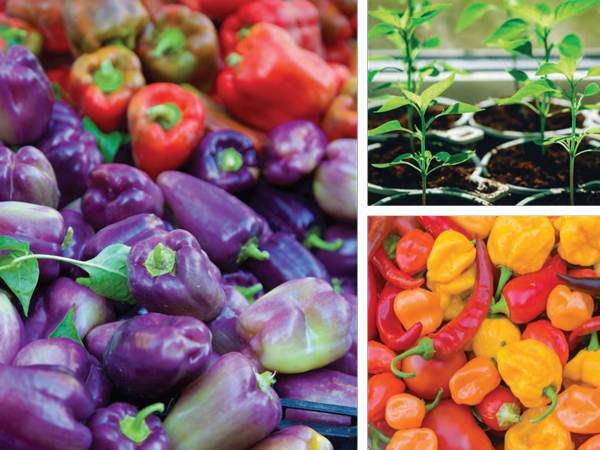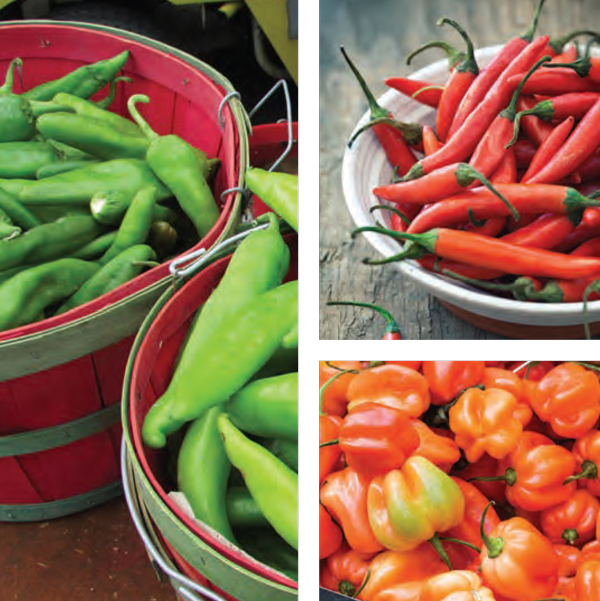Pick a Pepper | Popular Peppers for Every Taste
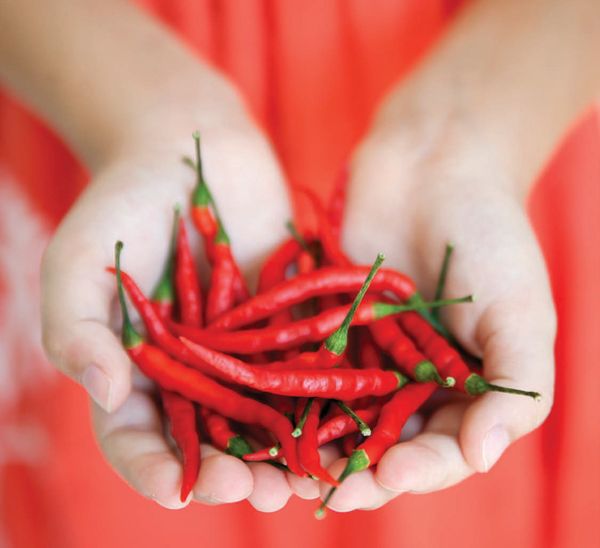
Whether sliced and sautéed into fajitas, stuffed with quinoa and baked, pureed into a spicy sauce or seared as a snack, peppers are an extremely versatile and fun ingredient for a variety of cuisines. Ranging from mild to burning hot, there’s a pepper for every taste and every culinary need.
Peppers 101
Peppers were once unique to the New World. While they could be found growing in Latin America and were integrated into cuisine there, they didn’t become known to Europe and Asia until after explorers brought them back. They now feature prominently in dishes from every corner of the world.
Chiles get their heat from capsaicin, a chemical present in the genus Capsicum, the family to which all peppers belong—from the mildest grocery store bell pepper to the hottest varieties. As peppers ripen from green to red they increase in capsaicin, so greener versions will be milder than more mature versions of the same peppers. Peppers pack a punch when it comes to nutrition, offering vitamins A, C and E, along with folate and potassium. Capsaicin is also believed to boost circulation.
While they vary in color, flavor and ideal use, a critical main difference between peppers is heat. Originally developed by Wilbur Scoville in 1912, the modern Scoville Heat Unit (SHU) scale helps us differentiate heat level among countless varieties of peppers. The most mild of peppers, such as red, orange or yellow bell peppers, can rate as low as a 0 on the scale. A Caribbean maintstay like Scotch bonnet peppers can hit a heat rating of 400,000 SHUs. A spicy jalapeño might fall around 8,000, where a mild poblano would be around 1,500. It’s not an exact science though, because the same pepper variety can vary in heat based on where it was grown, how long it was left to ripen, and other factors. And certainly, there are ranges between varieties. But checking the Scoville scale is a way to gauge roughly the kind of heat you can expect. It also helps with substitutions, so you don’t add an overly hot pepper to a dish meant for something mild. So be sure to hop online and do a quick Google search to investigate the range for any unfamiliar pepper you are thinking of using.
As a rough guide: mild peppers range between 0 and 4,000; medium peppers range between 4,000 and 15,000; and hot peppers range between 15,000 and 50,000. Taste test different types of peppers to see where your comfort zone might be—at least until you build a tolerance for the hotter varieties.
CHECKING THE SCOVILLE SCALE IS A WAY TO GAUGE ROUGHLY THE KIND OF HEAT YOU CAN EXPECT. IT ALSO HELPS WITH SUBSTITUTIONS, SO YOU DON’T ADD AN OVERLY HOT PEPPER TO A DISH MEANT FOR SOMETHING MILD. SO BE SURE TO HOP ONLINE AND DO A QUICK GOOGLE SEARCH TO INVESTIGATE THE RANGE FOR ANY UNFAMILIAR PEPPER YOU ARE THINKING OF USING.
In addition to choosing certain varieties, you can also prep peppers to control heat. Capsaicin is concentrated in the white pith and veins inside of the pepper, which means if you remove the seeds (including all pith connecting them) you’ll lower the heat. Always use caution when prepping hot peppers. These are the times to use disposable kitchen or medical gloves, so you can prep the peppers, clean the knife and cutting board and then take the gloves off. If you accidentally touch your eye with hot pepper oil on your hands, flush your eye repeatedly with water to control the sting.
Peppers are extremely easy to grow yourself. You can buy seedlings at a local home improvement store or start rarer varieties from seed. You can grow them in the ground, or in containers, and they don’t need a lot of TLC. Some good soil and regular watering will yield great results. You can have multiple varieties in your home garden, allowing you to pick what you need for various recipes. You can also dry them yourself in a low-heat oven, or using a dehydrator, so you can preserve them for future use. Or, you can make a simple hot sauce with a batch of mixed stragglers from the end of the season. Pulverize peppers in a blender with vinegar and salt (and other spices or sweeteners, if you choose) and then bring to a boil over medium heat. Store in an old glass salad dressing jar and enjoy with wings.
If you don’t have a green thumb, no worries. Check out your local grocery stores for fresh peppers, perhaps venturing to Latin or Asian markets for rarer fresh varieties. And don’t neglect the canned and jarred aisles. You can get wonderful ready-to-use peppers in the international sections of your local grocers.
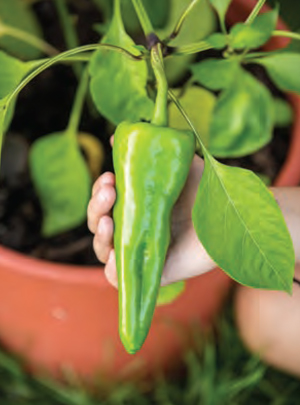 HOMEMADE HOT SAUCE
HOMEMADE HOT SAUCE
Making homemade hot sauce is easy and fun—and very forgiving. There are myriad recipes with varying levels or salt, vinegar and garlic, so experiment with what you like.
INGREDIENTS
About 20 peppers(either one kind, or a mix of hot varieties such as habanero, serrano, poblano, cayenne and jalapeno, or even a mix of hotter with sweeter varieties if you want a milder sauce)
- 3 teaspoons minced garlic(or more, to taste)
- ½ teaspoon salt (or more, to taste)
- 1 ½ cups distilled white vinegar or apple cider vinegar
Remove stems and tops of the peppers and cut in half. (Wear gloves if working with hotter varieties.) Combine peppers, garlic, salt and vinegar in a saucepan and bring to boil. Reduce heat and simmer for about 10 minutes, or until the peppers and garlic have softened. (If possible, work in a well-ventilated area, as the peppers will be pungent.) When done, remove saucepan from stove and cool to room temperature. Puree mixture in a blender or food processor until smooth. Taste, adding more salt if needed.
Transfer mixture to a clean glass jar and it’s ready to use, although flavor will be better if you wait 2 to 3 weeks. If sauce separates, just give it a shake. You can store in the fridge for up to six months.
INSPIRED BY RECIPE FROM DONTWASTETHECRUMBS.COM
Pick a Perfect Pepper
Here are some popular peppers, and some not-so-common varieties, ranked by heat.
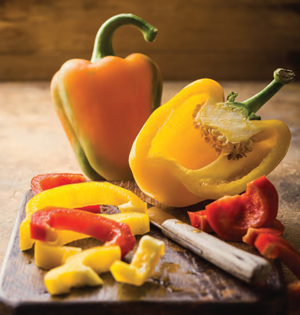 Bell (0–500 SHU)
Bell (0–500 SHU)
These are standard variety peppers you can buy year-round at the grocery store or in season at a local farmers market. They’re reliable, tasty and versatile. Bells come in a variety of colors. Red, orange and yellow are the most popular, but there are other varieties as well, including purple, white and pink. Green bell peppers are in fact under-ripe bell peppers, literally picked green and offering a bitter taste. As they ripen to other colors, they get sweeter. Bells have a high water content, so are great for recipes where you might want to add moisture. These are perfect raw in a veggie platter, sautéed in fajitas, or stuffed with grains and baked. Or you can roast them over a grill or gas stovetop, peel the skin and use them in salads. Interesting tip when picking them out at stores or farmers markets: Peppers with four lobes at the bottom are female peppers, which are slightly sweeter. Choose these for eating raw. Male peppers have three lobes and are better for baking or roasting.
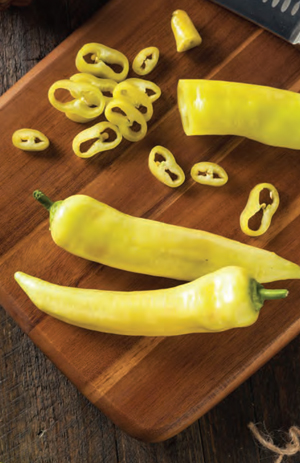 Banana (0–500 SHU)
Banana (0–500 SHU)
These are mild, tangy yellow peppers, great for salads and adding crunch to sandwiches. You may be more familiar with these when pickled and jarred, which you can find in the Italian section of your grocery store. This style is fantastic tossed on top of pizza.
Shishito (100–1,000 SHU)
These peppers are a fun option for a dinner party due to their somewhat unpredictable nature. Most are mild, but every so often you get one with more kick. These are very thin-walled and can therefore be quickly blistered, sautéed or pan-seared and eaten as an appetizer or side. They are often served drizzled with sesame oil and soy sauce. They are picked green but get spicier the longer they stay on the vine.
Poblano (1,000–2,000 SHU)
This is a delicious flavorful pepper that can be eaten green or when red and fully ripe, although the heat will increase significantly when they are red. These peppers are traditionally used for chile rellenos, a favorite dish in many Mexican restaurants, due to their thick walls. You might also know this pepper by its dried version: ancho. If you grow your own poblanos, you can leave some on the vine until they are dark red, then pick them and dry them. Then you can rehydrate them with a soak in hard water to use for recipes or pulverize in a mortar and pestle to create ancho spice, perfect for adding to a dry rub or to add smoky flavor to chili and sauces. They have a nice, rich balance of heat and sweet.
Hatch (1,000–8,000 SHU)
For over 130 years, New Mexico State University has been cultivating chiles unique to the Hatch Valley. The term “Hatch chiles” can therefore refer to multiple varieties grown in the area, which stretches north to south along the Rio Grande. Unless you live in New Mexico, you will have to look for fresh Hatch chiles in upscale grocery stores in August and September. However, you can usually buy them year-round jarred or canned in the Latin food section of your local grocery store. These are wonderful to add in recipes like enchiladas suizas or pork chili. Need a quick game-time snack? Microwave canned Hatch chiles with some classic Velveeta to make a quick queso dip for tortilla chips.
Jalapeño (3,500–8,000 SHU)
Whether stuffed with cream cheese and deep fried, or sliced thin in a spicy salsa, jalapeños are the workhorses of the medium-level peppers. They are exceptionally easy to grow, and easy to buy at grocery stores, fresh or canned. They are normally used green, in their mildest form, but they can also be allowed to ripen to bright red for more kick as well as sweetness. Like poblanos, jalapeños have an alter ego when dried: chipotle.
Serrano (10,000–23,000 SHU)
Once you’ve graduated from jalapeños and are ready for something a little hotter, serranos are a nice next step. Long and lean, they have thin skins so you can roast them and then chop (without peeling) and add to sauces and chili for some extra heat. They have a wide SHU range though, so taste test to make sure the variety you have isn’t too hot.
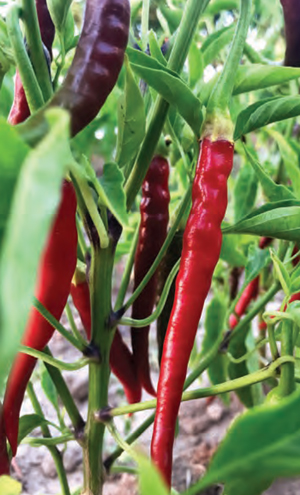 Thai (50,000–100,000 SHU)
Thai (50,000–100,000 SHU)
Some of the prettiest peppers to grow in containers, Thai chiles are only 1-2 inches long and very thin, so they look ornamental. With nearly 80 different varieties, all of which are hot, you can choose any number to grow in hanging baskets or alongside flowers in containers. You can also find them in some stores fresh, and in most stores canned or jarred. These are excellent to flavor sauces and curries—especially in seafood dishes, stews and soups—and to give heat to some favorite dishes like pad Thai.
Scotch Bonnet (80,000–400,000 SHU)
These peppers are favorites in the Caribbean islands, most notably in Jamaican cuisine, including jerk chicken and chutney. They are also excellent in hot sauces. They have a squashed shape, resembling Scottish tam o’shanter caps, hence their name. They are lovely in color, coming in bright yellow, orange or red. They can also be used interchangeably with habaneros.
These are only a sampling of the copious pepper varieties available to grow via seed or seedlings, or to buy fresh or jarred. They add depth and flavor to multiple cuisines, from Super Bowl snacks to Asian noodles, Mexican classics to Caribbean specialties. So don’t be shy: Pick a pepper, and experiment with varieties with various levels of heat. ✦
Banana pepper, Bell pepper, capsaicin, Chiles, Features, Hatch pepper, Jalapeño, pepper, Poblano pepper, Scotch Bonnet, Scoville Heat Unit (SHU), Serrano pepper, Shishito pepper, Thai pepper

